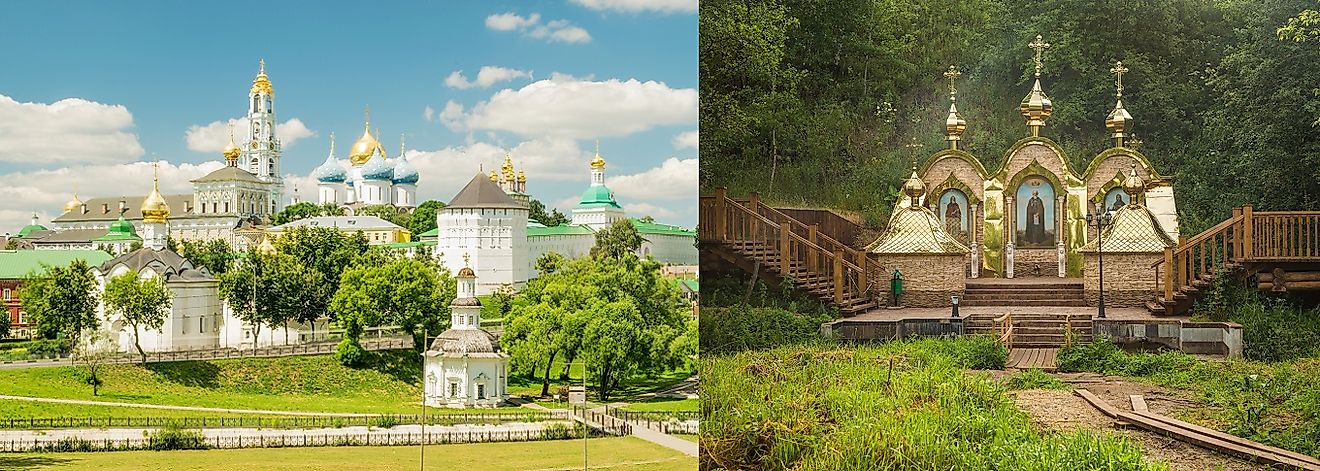UNESCO World Heritage Sites In Russia

Russia, the largest country in the world by land area, spreads across much of northern Asia and Eastern Europe. Because of its unique location, it is often said that Russia is the link between these two continents. Many historic monuments and natural areas, protected as UNESCO World Heritage Sites, demonstrate that connection. In total, Russia has 26 World Heritage Sites, 16 are cultural and 10 are natural. This article takes a look at some of those sites.
UNESCO World Heritage Sites
Trinity Lavra of St. Sergius Monastery
The Trinity Lavra of St. Sergius is a working Russian Orthodox monastery. It is located approximately 43 miles northeast of Moscow and is home to 300 monks. Originally built during the 14th Century, the first wooden church stood here for 71 years before it was destroyed in a Tartan raid. Its founder, Sergius of Radonezh, was made a saint in 1422, the same year that the first stone church was built on this site. The church became the traditional place for royal baptisms. In 1559, Ivan the Terrible had the Assumption Cathedral built at the location. It took 26 years to complete. The monastery continued growing over the next several centuries. In the 1690’s, the Church of John the Baptist’s Nativity was built, unique for its 5-dome structure. Some of the earliest examples of glazed tile can be found here along with the Last Supper by Simon Ushakov. This site is also one of the last remaining Russian churches with a bell tower. During the Russian Revolution of the early 1900’s, the monastery was closed and many valuable items were sold, some of the buildings became museums. Service was not restored until the 1940’s. The Trinity Lavra of St. Sergius became a World Heritage Site in 1993.
Bolgar
Next on the list is the Bolgar Historical and Archaeological Complex, located along the Volga River. It became a UNESCO World Heritage Site in 2014 because it provides a look into the Eurasian cultural exchanges that took place over centuries, forming civilizations and traditions. Its history dates back as far as the 8th Century when it became the capital of Volga Bulgaria. This site is a reminder that the Volga-Bolgars accepted Islam in 922 AD. This acceptance continued to have both cultural and archaeological influence over the region for many years. During the Mongol reign, it became wealthy and grew rapidly. Many invasions occurred here from Turco-Mongol invaders to Russian pirates, however it stood as an important Muslim center through Khanate of Kazan in the 16th Century. The Russian Czar Ivan IV conquered the area and claimed it as a Russian state in the mid-1500’s. The architectural styles here show influence from several cultures, including the Turkic, Finno-Ugric, and Slavic. It continues to be a sacred pilgrimage site for Tartar Muslims.
Central Sikhote Alin Mountains
The Central Sikhote Alin mountain range was inscribed as a natural UNESCO World Heritage Site in 2001. This location is particularly important because of its unique ecosystem. In this part of the mountain range, a mix between taiga and subtropic temperate forests thrives. This is significant because southern species, such as tigers, are able to survive with northern species, such as brown bears. The site is large and covers the area from the mountains to cost of the Sea of Japan. Because of its unique habitat, this area has developed a large number of endemic plant and animal species. It is considered one of the most unique natural areas in the world and is critical for the survival of many endangered species including the Amur tiger, Blakiston’s fish-owl, and the Chinese merganser.
Other UNESCO World Heritage Sites in Russia can be found listed in the table below.
Preserving Russian Culture
Russian culture has a long and unique history, influenced by many Eurasian traditions. It represents the result of mixed ideologies, religions, and heritage. Here, Eastern Slavs, Finno-Ugric tribes, and Iranian nomads combined with Orthodox Christianity and Islam to create the unique Russian cultural heritage seen in modernity. Protecting the places that show evidence of this Eurasian history helps provide future generations with an understanding of the past. Currently, Russia has 24 more locations on the tentative list to become UNESCO World Heritage Sites.
UNESCO World Heritage Sites In Russia
| UNESCO World Heritage Sites in Russia | Year of Inscription; Type |
| Architectural Ensemble of the Trinity Sergius Lavra in Sergiev Posad | 1993; Cultural |
| Bolgar Historical and Archaeological Complex | 2014; Cultural |
| Central Sikhote-Alin | 2001; Natural |
| Church of the Ascension, Kolomenskoye | 1994; Cultural |
| Citadel, Ancient City and Fortress Buildings of Derbent | 2003; Cultural |
| Cultural and Historic Ensemble of the Solovetsky Islands | 1992; Cultural |
| Curonian Spit | 2000; Cultural |
| Ensemble of the Ferapontov Monastery | 2000; Cultural |
| Ensemble of the Novodevichy Convent | 2004; Cultural |
| Golden Mountains of Altai | 1998; Natural |
| Historic and Architectural Complex of the Kazan Kremlin | 2000; Cultural |
| Historic Center of Saint Petersburg and Related Groups of Monuments | 1990; Cultural |
| Historic Monuments of Novgorod and Surroundings | 1992; Cultural |
| Historical Center of the City of Yaroslavl | 2005; Cultural |
| Kizhi Pogost | 1990; Cultural |
| Kremlin and Red Square, Moscow | 1990; Cultural |
| Lake Baikal | 1996; Natural |
| Lena Pillars Nature Park | 2012; Natural |
| Natural System of Wrangel Island Reserve | 2004; Natural |
| Putorana Plateau | 2010; Natural |
| Struve Geodetic Arc | 2005; Cultural |
| Uvs Nuur Basin | 2003; Natural |
| Virgin Komi Forests | 1995; Natural |
| Volcanoes of Kamchatka | 1996; Natural |
| Western Caucasus | 1999; Natural |
| White Monuments of Vladimir and Suzdal | 1992; Cultural |











